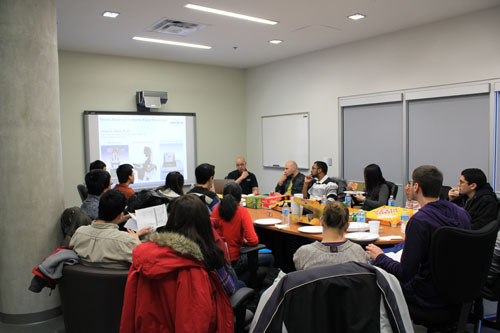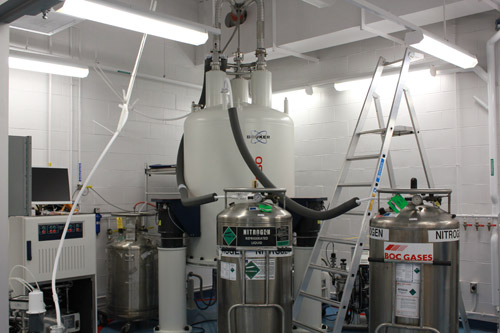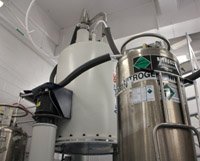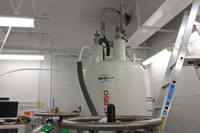Newsroom
Seminar: Functional Hybrid silicas and applications with Dr. Michel Wong Chi Man
Date: Friday, May 10, 2019
Time: 1:30 PM
Location: ETB 535
Please note, registration is NOT required for this event.
Bridged silsesquioxanes (BS) is a family of hybrid silicas which are obtained by the hydrolysis-condensation of silylated precursors with bridging organics, (EtO)3Si-R-Si(OEt)3 (R = organic fragments). Thanks to the mild sol-gel reaction conditions, the relatively strong covalent Si-C bonds are maintained during the reaction, resulting in the formation of unique hybrids, which consist of a uniform distribution with stoichiometric Si/C ratio of covalently bonded organics interconnecting at least two silicon atoms.
These hybrid organic-inorganic materials combine the inherent properties of the organic fragments with those of the silica network (mechanical and chemical stabilities as well as high surface area and porosity). Accordingly to the variety of organic units that can be introduced in BS, one can tune the properties of the final materials for targeted applications (e.g. catalysis, optics, magnetic and imaging, etc.). Moreover, these hybrids can be structured in mesoporous materials when synthesized with a surfactant. The resulting hybrid is called Periodic Mesoporous Organosilicas (PMO).
In this presentation, the design of selected BS precursors will be shown. The role of the organics for catalysis applications, the self-directed structuring as well as template-mediated structuring of these hybrids, called PMO6, will also be addressed. The synthesis of functional hybrid mesoporous and of nano-PMOs will be presented and their use as drug carriers will also be presented.
Michel WONG CHI MAN is a senior researcher at the French National Centre for Scientific Research (Centre National de la Researche Scientifique; CNRS). He is an expert in organosilicon and hybrid silica chemistry and has published over 160 articles in peer-reviewed journals in these fields. His main research interests focus on the functionalization of hybrid silica (mainly bridged silsesquioxanes), which he develops in several different areas: Nano-structuring of hybrid silicas; catalysis; photoluminescent materials; stimuli-responsive hybrid silica nanoparticles for drug delivery.
For more information, contact: Biointerfaces Institute 905-525-9140 x 20706
Workshop: Developing Clinical Point-of-Care (POC) Diagnostics
The Fraunhofer Project Centre for Biomedical Engineering and Advanced Manufacturing (FPC-BEAM) is hosting a workshop on the challenges of developing clinical diagnostics in specific fields and opportunities for POC diagnostics. The two-day workshop will bring together various stakeholders for presentations, panels and open forums to discuss the ideal POC diagnostic, POC development and the support systems needed to bring these diagnostic healthcare solutions to market.
We're Hiring -- Project Manager
The Project Manager will provide daily leadership, direction, and operational management for the ORF grant. This individual will also function in the capacity of alliance and business development manager, liaising with all parties involved in the project (i.e. industry partners, researchers, and the university partners) to ensure the team is well-functioning and will work with MILO to protect and license IP, and guide business development efforts.
The Project Manager will organize and prepare materials for meetings of the Board of Directors and all other committees, and will be responsible for and ensure the execution of the actions approved by these committees.
Heather Sheardown secures $4 million
Congratulations to Heather Sheardown for securing $4 million for her research project: Responsive Materials for Ocular Therapy.
Read more at the Daily News
Interdisciplinary Research Fund supports six innovative projects
Congratulations to member Dr. Tohid Didar on receiving IRF funding for the project title: Development of a point-of-care microfluidic chip for rapid diagnosis of Von Willebrand disease.
Read more at the Daily News
We're Hiring!
We are currently looking for Postdoctoral Fellows in the area of Point of Care Diagnostics.
Suitable candidates must hold a Ph.D. and have a strong background in one or more of the following areas: aptamer selection and optimization (3 positions); solution- and solid-phase assay development (2 positions); surface derivatization and printing (2 positions); prototyping and device development (e.g. 3D printing, additive manufacturing, etc) (2 positions). The successful candidates will work as part of a team of researchers focused on delivering industry diagnostic tests in a milestone-driven manner. Candidates should submit a cover letter, CV and the names and contact information (address, phone number and email address) of three referees. Please note that the positions will be roughly 2 years in length.
To apply, please visit working at mcmaster
Optimization of biomolecule separation by combining microscale filtration and design-of-experiment methods
One of our BI members David Latulippe just had a paper from his group accepted for publication in Biotechnology and Bioengineering. We are very pleased to provide access to our micro plate reader and gel imaging systems which are used by David Latulippe and his group.
MP Mike Lake tours McMaster Institutes
We would like to thank MP Mike Lake, for touring the IIDR and the Biointerfaces Institute.
Upcoming Event: Injectable sol - gel derived alumina
The CREATE program is hosting an event: Injectable sol - gel derived alumina: synthesis, properties, biomedical applications
This study has been motivated by a major obstacle in the use of glassy and ceramic materials as injectable biocompatible carriers: Despite the fact that the vast majority of oxide-based biomaterials studies have been carried out on silica, no major pharmaceutical company has 'raised the glove' to get the FDA and the other regulatory agencies approval for this material as an injectable carrier of therapeutical components.
MP Mike Lake visits campus
McMaster students had a chance to discuss autism awareness and the concept of a national autism strategy with a federal MP last week.
Mike Lake, MP for Edmonton-Mill Woods-Beaumont, holds autism awareness close to his heart and has been an active supporter of autism organizations, families and individuals across the country, sharing his story of life with his son Jaden, who has autism.
Read more at DailyNews
Math geek turned Neuroscientist's new site is the Match.com of research equipment
Brandon Aubie just wanted to connect more researchers with McMaster's Biointerfaces Institute. He ended up creating a whole new company. The self-described "math geek turned neuroscientist" has created what might just be the Match.com of research equipment and expertise, and the site is now taking off across the country.
QReserve launches McMaster’s turn-key research equipment database
It’s an online ‘library’ for research equipment that first began in the Biointerfaces Institute (BI), McMaster’s – and Canada’s – premier research facility for developing unique surfaces at the interface of biology and materials. The BI is home to a vast array of high-tech equipment, machines and instrument suites in a shared environment designed to connect researchers and industrial users from multiple disciplines.
Engineered to Change the World: Turning the Water Testing Process Upside Down
remarkable discovery by a team of researchers at the Biointerfaces Institute at McMaster University will enable people all over the world to determine in seconds if their water is safe. Dr. Carlos Filipe, lead researcher at the institute and chair of chemical engineering, and Sana Jahanshahi-Anbuhi, a Ph.D. student in chemical engineering, describe this breakthrough discovery and how the research-focused student-centred environment within McMaster Engineering inspires innovation that transforms the world.
McMaster spin-off QReserve hopes to become the eBay of lab equipment
After Brandon Aubie earned his PhD at McMaster University, he joined the university’s Biointerfaces Institute, which opened in 2013 with $22 million in funding from the Canada Foundation for Innovation, the provincial government and industry partners. “We had tons and tons of really cool equipment that we figured everybody would want to use,” he recalls. “But we had a lot of trouble getting people to come in to our facility to use it.” The reason, he says, is that few people outside of the institute knew the equipment existed.
QReserve
Billions of dollars in taxpayer funded research equipment sits idle in university and college labs across Canada and the world. Simultaneously, many researchers and businesses are eager to utilize these resources and form new collaborations.
Read more at Innovation Factory
McMaster researchers work to make vaccines more accessible
A research project using equipment of McMaster University's Biointerfaces Institute has the potential to make vaccines for deadly illnesses much more affordable and available worldwide.
Forget the fridge: McMaster researchers develop new storage method for vaccines
Forget fridges and cumbersome packaging, researchers have developed a new method to store vaccines for months at a time without refrigeration. It’s a practice could help revolutionize and improve health care in areas of the world without reliable electricity.
Read more at The Globe and Mail.
Melt in your mouth vaccine
Those melt-on-your-tongue mouthwash strips on sale at the grocery checkout don’t just zap your foul-smelling pizza breath — it turns out they have spawned potentially life-saving public-health innovations, too.
Read more at CBC
This Little Pill Can Tell You When Your Water’s Bad And Your Meat's Rotten
At first, minty-fresh breath strips vowed to transform the way people prepared for a make-out session. But researchers say that the sugary, flexible material is actually capable of far more. The same stuff we use to freshen our breath could soon be deployed to detect dangerous chemicals and bacteria in drinking water.
Read more at Fast Company
Printed sensors kick up a stink
Scientists in Canada have used an inkjet-printer to create sensors that give off a smell when a target biomolecule is present.
Read more at Chemistry World
Bruker 850MHz NMR
The Bruker 850MHz NMR is now fully opertationally. Please contact us if you require use of this instrument.
Welcome our newest member

The Biointerfaces Institute welcomes our newest member, Dr. Ryan Wylie, who will be joining McMaster University on July 1, 2014.
For more information on Dr. Wylie’s research interests, please click here.
Scientists pack lab into pill using idea inspired by breath-freshening strips
A McMaster team from the Biointerfaces Institute has reduced the sophisticated chemistry required for testing water safety to a simple pill, by adapting technology found in a dissolving breath strip. Want to know if a well is contaminated? Drop a pill in a vial of water and shake vigorously. If the colour changes, there’s the answer. Read More
Biointerfaces Research Gateway

The Biointerfaces Institute is pleased to launch the Biointerfaces Research Gateway (BiRG), an online database of biointerface interactions and suite of data analysis tools. Our mission is to lower the barrier to data access in the biointerfaces research community by curating high-throughput data into an easy to access online format for use in online expert analysis.
83 Bold Innovations to Improve Global Health
Dr. Parameswaran Nair, Associate Professor, Medicine and Dr. John Brennan, Director, Biointerfaces Institute have a received a seed grant of $100,000 from Grand Challenges Canada, funded by the Government of Canada for their project "A point-of-care paper-based biosensor to detect and treat bronchitis"
For more information please click on the following link:
Newswire
How safe is your drinking water?
Saving lives by making water safe, the art of planet hunting and the magic of nano-magnets are among the research topics being explored by Ontario’s top researchers as McMaster kicks off this year’s speaker series, Research Matters. - See more at: Daily News
What Matters Now Hamilton - Free Speakers Series
Come out to an informative and interactive event featuring five of Ontario’s top researchers – including McMaster’s own Dr. John Brennan, Director of the Biointerfaces Institute.
Listen. Debate. Have your say. Weigh in on what matters: is it making sure our water is safe? Hunting for other worlds? Nano-magnets? Social innovation? Building intelligent machines?
The event will take place at the McMaster Innovation Park as we kick off this year’s popular free speaker series, Research Matters, moderated by journalist and broadcaster Piya Chattopadhyay.
Doors open at 6:30 pm, event begins at 7pm followed by a reception with light refreshments in The Atrium at 9:00 p.m.
This event is FREE and all are welcome. Seating is limited so register online or by voice mail: 905-525-9140 extension 24934.
This event will also be webcast live and remote viewers can have their say and ask questions via Twitter using the hashtag#whatmattersnow. To register, get webcast info, and learn more about your Ontario research visit yourontarioresearch.ca/events/what-matters-now
Developing Quantitative Sol-gel Derived Protein Microarrays
To read more, please visit the article page at JoVE. Click here.
Bioactive paper will revolutionize point-of-care diagnostics

McMaster University (By Kim Wright)
A pair of University researchers have received a $600,000 CIHR award to develop a bioactive paper that aims to provide an inexpensive, point-of-care diagnostic tool to measure bronchitis in patients with airway diseases, such as asthma, COPD and chronic cough.
Dr. Parameswaran Nair, associate professor, Medicine, holds the CIHR Canada Research Chair in Airway Inflammometry. Dr. John Brennan is a Canada Research Chair in Bioanalytical Chemistry, and director of McMaster's new BioInterfaces Institute. The research is supported by AllerGen NCE, a national network for asthma and allergic diseases research, headquartered at McMaster.
Biointerfaces Institute Grand Opening Video
Full footage of Biointerfaces Institute Grand Opening ceremonies now available. Relive the excitement or see it here for the first time!
The Globe and Mail
The Globe and Mail has run a feature article in their Report on Business section dealing with the BI's interaction with industrial partners.
Read more at the Globe and Mail Article.
Grand Opening Ceremony and Symposium a Great Success
Photo gallery to follow soon
AFM Technology Seminar

On March 6 and 7, 2013, the Biointerfaces Institute hosted the AFM Technology Seminar. During the two day workshop, Dr. James Shaw, a life science application scientist from Bruker Nano Surfaces, presented the latest technological advances in Bruker Atomic Force Microscopes. Researchers from both McMaster University and the University of Toronto had the opportunity to run samples on the BioScope Catalyst AFM at the BI under the helpful guidance of Dr. Shaw.
Congratulations to Emily Grinberg
The Director and Laboratory Manager congratulate Emily Grinberg for placing 1st in the Life Sciences Division at St. John's-Kilmarnock School's science fair this past Monday. Emily's project involved looking for mutagens in both breast milk and powder baby food. Emily is now off to the regional science fair at Bingeman's Park in April. Good work Emily!
Reading Week Workshops Available
We are pleased to announce reading week introductory workshops on Thursday, February 21st 2013.
Please register here!Biosafety Level 1 and 2 Certification Completed
As of Wednesday, February 6th, 2013, the Biointerfaces Institute is Biosafety Level 1 (BSL-1) and Biosafety Level 2 (BSL-2) certified.
The 850 MHz NMR Has Arrived
The new Bruker 850MHz NMR, part of BioInterfaces Institute Directed by John Brennan, has arrived in ABB.






